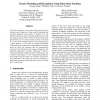Free Online Productivity Tools
i2Speak
i2Symbol
i2OCR
iTex2Img
iWeb2Print
iWeb2Shot
i2Type
iPdf2Split
iPdf2Merge
i2Bopomofo
i2Arabic
i2Style
i2Image
i2PDF
iLatex2Rtf
Sci2ools
FGR
2000
IEEE
2000
IEEE
Gesture Modeling and Recognition Using Finite State Machines
This paper proposes a state based approach to gesture learning and recognition. Using spatial clustering and temporal alignment, each gesture is defined to be an ordered sequence of states in spatial-temporal space. The 2D image positions of the centers of the head and both hands of the user are used as features; these are located by a color based tracking method. From training data of a given gesture, we first learn the spatial information without doing data segmentation and alignment, and then group the data into segments that are automatically associated with information for temporal alignment. The temporal information is further integrated to build a Finite State Machine (FSM) recognizer. Each gesture has a FSM corresponding to it. The computational efficiency of the FSM recognizers allows us to achieve real-time online performance. We apply the proposed technique to build an experimental system that plays a game of “Simon Says” with the user.
Related Content
| Added | 31 Jul 2010 |
| Updated | 31 Jul 2010 |
| Type | Conference |
| Year | 2000 |
| Where | FGR |
| Authors | Pengyu Hong, Thomas S. Huang, Matthew Turk |
Comments (0)

